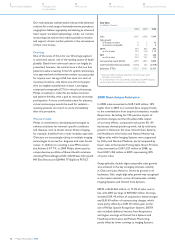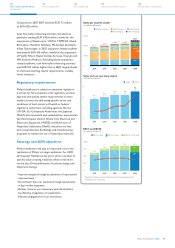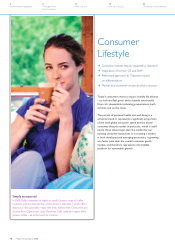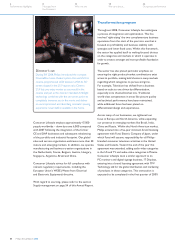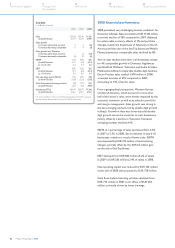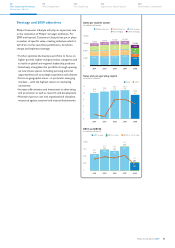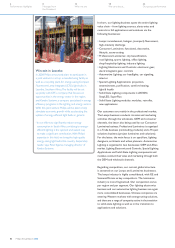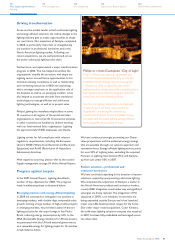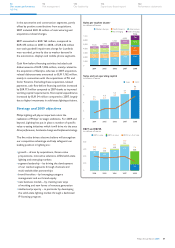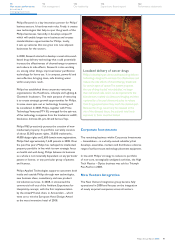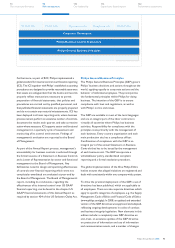Philips 2008 Annual Report Download - page 85
Download and view the complete annual report
Please find page 85 of the 2008 Philips annual report below. You can navigate through the pages in the report by either clicking on the pages listed below, or by using the keyword search tool below to find specific information within the annual report.
1 in 3
cars worldwide
uses Philips
automotive
lighting
Lighting landscape
Overall, we see three main transitions that will affect
the lighting industry in the years to come. The first is
from incandescent lamps to energy-efficient light sources
.
Rising energy prices and increased awareness of climate
change are creating a greater demand for energy-saving
lighting. As a result, the market for innovative, efficient
and sustainable lighting solutions is growing.
The second transition is the move from traditional
vacuum-based technologies to solid-state lighting
technology. Solid-state or LED lighting is the most
significant development in lighting since the invention
of electric light well over a century ago. Offering
unprecedented freedom in terms of color, dynamics,
miniaturization, architectural integration and energy
efficiency, solid-state lighting is opening up exciting
new possibilities.
The third transition is from the bulb and components
as the point of value creation in the lighting industry
to applications and solutions. Lighting expertise based
on end-user insights is integrated into the application,
system or solution. Increasingly, these applications and
solutions will include controls, and so a key differentiator
in the future will be the innovative strength to create
systems and solutions that are truly customer-centric.
Like other industries, however, the lighting industry
is not immune to macro-economic developments.
The slowdown in the automotive and construction
sectors, tighter availability of credit and weaker spending
on public infrastructure projects had an impact in 2008
and the continuation of these trends in 2009 could slow
the above transitions for us and many of the players in
the industry.
Solutions for people’s needs
Philips Lighting is dedicated to improving people’s lives
through the introduction of innovative and energy-efficient
solutions or applications for lighting. Our approach is
based on obtaining direct input both from customers
and from end-users/consumers. Through a segment-
based approach, we can assess customer needs in a
targeted way, track changes over time and define new
insights that fuel our innovation process and
ultimately
increase the success rate of new propositions introduced
onto the market.
We aim to be the true front-runner in design-led,
market- and consumer-driven innovation – both in
conventional lighting and in solid-state lighting – while
continuing to contribute to responsible energy use
and sustainable growth.
About Philips Lighting
Philips Lighting is the global market leader,
with recognized expertise in the development,
manufacturing and application of innovative lighting
solutions. We have pioneered many of the key
breakthroughs in lighting over the past 100 years,
laying the basis for our current position.
We address people’s lighting needs across a full range
of environments. Indoors, we offer specialized lighting
solutions for homes, shops, offices, schools, hotels,
factories and hospitals. Outdoors, we provide lighting
for public spaces, residential areas and sports arenas.
We also meet people’s needs on the road, by providing
safe lighting for traffic (car lights and street lighting) and
elsewhere. In addition, we address people’s desire for
light-inspired experiences through architectural projects.
Finally, we offer specific applications of lighting in
specialized areas, such as horticulture, refrigeration
lighting and signage, as well as heating, air and water
purification, and healthcare.
Elegance meets efficiency
Offering up to 80% energy saving compared with
standard dichroic low-wattage halogen lamps and
incandescent spot lamps and 45,000 hours of high-
quality light, the Philips MASTER LED range opens
up a whole new world of spot and general lighting
solutions. The energy efficiency and long lifetime
of LEDs have now been applied to meet the need
for a long-lasting, cost-efficient lamp in functional
applications. MASTER LED particularly benefits
hospitality and retail sector owners and managers
who want to reduce the energy consumption of their
hotels, restaurants and clubs but will not compromise
on perceived quality of light.
Philips Annual Report 2008 85
122
Performance statements
114
Supervisory Board report
110
Our leadership
94
Risk management
70
Our sector performance
Lighting



